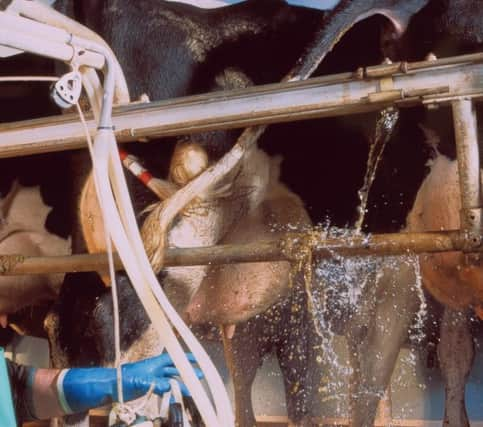Will you vaccinate your cattle against leptospirosis?


How common is leptospirosis in Northern Ireland?
Leptospirosis is a common infection in beef and dairy herds. Approximately 75% of UK cattle have been exposed to Leptospira hardjo, for which they are the “maintenance” host. After infection cows harbour the bacteria in their kidneys for months, even years, excreting many leptospires in their urine so acting as a reservoir of infection for other cattle.
Leptospira spp. are difficult to culture and leptospirosis is therefore likely to be an under-diagnosed cause of abortion in cattle.
Advertisement
Hide AdAdvertisement
Hide AdIn 2016 Leptospira hardjo was detected in 14 cases or 3.2% of foetuses submitted to AFBI in Northern Ireland.
What is the cost of the disease?
The overall costs of disease caused by leptospires average out at £68- £106/ cow in an affected herd. This works out at a loss of 0.91-1.41 pence per litre.
Economic losses result from:
Milk drop or flabby bag. A sudden milk drop occurs two to seven days after infection of susceptible cows. The udder becomes soft and flabby with colostrum-like secretions or blood-tinged milk in all four quarters. Signs may be mild and go undetected, but some cows become lethargic and stiff with a fever and reduced appetite.
In 2014 the Scottish Agricultural Colleges Consulting Services (SAC C VS) diagnosed leptospirosis in a 160 cow dairy herd where twelve cows experienced a sudden drop in milk production, with no other clinical signs observed. The affected animals had access to a stream shortly before the first case of milk drop was observed. The natural watercourse was considered as the source of infection.
Advertisement
Hide AdAdvertisement
Hide AdAbortion. Abortion may occur three to twelve weeks following infection with most abortions occurring in the last three months of pregnancy. Infection may also produce premature or weakly calves.
Infertility or subfertility. Leptospires in the uterus can cause inflammation, which leads to early death of the embryo and the cow returning to service.
How does leptospirosis spread?
Disease is usually introduced in a herd by the purchase of infected cattle. L. hardjo has also been recovered from the urine of sheep; therefore sheep on the farm increase the likelihood of infection in cattle.
Leptospires survive in warm wet conditions and can last up to four months in the environment with peak transmission times from June to October.
Advertisement
Hide AdAdvertisement
Hide AdInfection usually occurs when cattle come in contact with contaminated urine. Leptospires can stay in the kidneys of infected cattle for a long period of time and these cattle will shed leptospires either intermittently or continuously for days or even years.
Direct transmission can also occur via the post-abortion discharge, via the infected placenta and by sexual contact through semen of infected bulls.
The leptospires gain entry via the mucous membranes (eyes, nose, mouth, genital tract) and progress to three key organs: the udder, the uterus and the kidneys.
Infection can also be transmitted transplacentally- foetuses may be infected at birth and harbour infection in the kidneys.
Can humans contract leptospirosis?
Advertisement
Hide AdAdvertisement
Hide AdL. hardjo infection is a zoonosis; the infection is transmissible to man. Sources of infection for humans include urine, uterine discharges and abortion material. Dairy farmers are at increased risk to contract leptospirosis. Signs of infection include fever, headaches, muscle pain. Death is rare and results from liver and kidney failure.
How can I protect
my herd?
Biosecurity measures could help reduce the risk of exposure to infection; however it would be very difficult to completely eradicate bovine leptospirosis in the UK because of the high percentage of herds infected.
In practical terms, vaccination will often be the best control option.
Spirovac® protects against Leptospira borgpetersenii serovar Hardjo for a period of 12 months. Vaccination reduces urinary shedding and this effect appears four weeks after vaccination.
Advertisement
Hide AdAdvertisement
Hide AdCalves may be vaccinated from four weeks of age and should initially be vaccinated with two doses of vaccine separated by a four to six week interval. Boosters should be given on an annual basis.
Will vaccination provide a return on investment?
In August 2016 SAC Dumfries reported two confirmed cases of leptospirosis in dairy herds. In one of the herds vaccination had lapsed as a cost saving measure. Stopping vaccination is certainly a very quick way of reducing farm expenditure, but can you afford to take the risk from a potential disease recurrence?